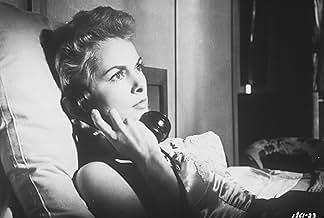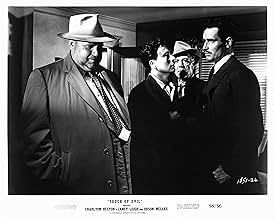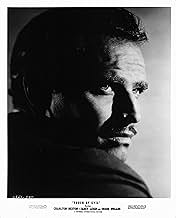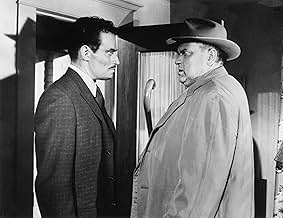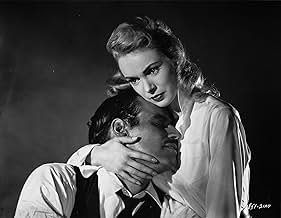Eine schonungslose, vollkommen verquere Geschichte über Mord, Geiselnahme und Polizeikorruption in einer mexikanischen Grenzstadt.Eine schonungslose, vollkommen verquere Geschichte über Mord, Geiselnahme und Polizeikorruption in einer mexikanischen Grenzstadt.Eine schonungslose, vollkommen verquere Geschichte über Mord, Geiselnahme und Polizeikorruption in einer mexikanischen Grenzstadt.
- Auszeichnungen
- 7 Gewinne & 1 Nominierung insgesamt
Valentin de Vargas
- Pancho
- (as Valentin De Vargas)
Empfohlene Bewertungen
10Dr.Teeth
There are only two ways to write a review that would truly do this film justice. Either one would have to write an exceedingly long review, or a short, concise one. I choose to do the latter.
When I first saw "Touch of Evil," I was glued to the chair. When I found out it was not Welles' definitive vision, I wondered how on earth it could have been made better. And when I saw the re-released version, I wondered why the studio altered it. The stunning black-and-white images, the intricate plot, and the powerful, engaging performances took a hold of my imagination. At times, I imagined myself on the street with the characters, because the atmosphere was so thick I felt surrounded in it.
The actors all did an outstanding job, especially Leigh and Heston (who, although not thoroughly convincing as a Mexican, soared above his usual powerful, furious presence). This is Welles' picture, however, and whenever the camera catches his obese figure, you are fully aware of the man as a director and an actor. His powerful vision drives the film, from the single-cut opening sequence to the cat-and-mouse finale.
I suggest watching the 1998 restored version over the original theatrical release, but regardless of which version, "Touch of Evil" will have you stuck in your seat, questioning your views of morality until long after the last credit has rolled up the screen.
When I first saw "Touch of Evil," I was glued to the chair. When I found out it was not Welles' definitive vision, I wondered how on earth it could have been made better. And when I saw the re-released version, I wondered why the studio altered it. The stunning black-and-white images, the intricate plot, and the powerful, engaging performances took a hold of my imagination. At times, I imagined myself on the street with the characters, because the atmosphere was so thick I felt surrounded in it.
The actors all did an outstanding job, especially Leigh and Heston (who, although not thoroughly convincing as a Mexican, soared above his usual powerful, furious presence). This is Welles' picture, however, and whenever the camera catches his obese figure, you are fully aware of the man as a director and an actor. His powerful vision drives the film, from the single-cut opening sequence to the cat-and-mouse finale.
I suggest watching the 1998 restored version over the original theatrical release, but regardless of which version, "Touch of Evil" will have you stuck in your seat, questioning your views of morality until long after the last credit has rolled up the screen.
Rather than films like Citizen Kane (1941) and The Lady from Shanghai (1947), neither of which am I a big fan of, Touch of Evil evidences director/writer/star Orson Welles' capacity for cinematic genius. The story is engaging, suspenseful, tight and well paced; the cinematography is consistently beautiful, inventive and symbolic; the setting and overall tone of the film, including the performances, are captivating, yet slightly surreal and otherworldly; and there are many interesting subtexts. This all combines to create a complex artwork that will reward however far a viewer wishes to dig into the film.
Based on a novel by Whit Masterson, Badge of Evil, Touch of Evil is a battle between two policemen--Hank Quinlan (Orson Welles) and Ramon Miguel Vargas (Charlton Heston). Parallel to this is a kind of border battle between the United States, represented by Quinlan, and Mexico, represented by Vargas; the film is set in two border towns, frequently crossing over.
As Touch of Evil opens, we see a bomb being placed in the trunk of a car in Mexico. A construction company owner, Mr. Linnekar, gets in with his girlfriend. Vargas and his new wife, Susan (Janet Leigh), manage to walk along next to the car--they're all crossing the border into the United States. Shortly after crossing, the bomb goes off. This brings the gruff Quinlan into the picture. His investigation of the bombing brings him into Mexico for suspects. Meanwhile, Vargas and his wife are being threatened by Joe Grandi (Akim Tamiroff), a Mexican mob boss, and his underlings. Both Quinlan and Vargas are well respected in their countries, and both are used to getting what they want. But the bombing investigation ends up putting them at loggerheads, and Quinlan gradually turns out to have more than a "touch of evil".
As with many of his films, Orson Welles ended up having to battle the studio to realize his artistic vision. Usually, as here, the battle was unsuccessful for him. Despite his 58-page memo detailing various problems with Universal's non-director supervised reshoots (by Harry Keller) and re-edits, because they felt that Welles' final cut "could use some improvement", the film was released in a form that was not satisfactory to Welles. The fiasco has resulted in various versions of Touch of Evil appearing throughout the years. The 58-page memo was thought to have been lost, but a copy was discovered relatively recently in Charlton Heston's possession. The film was recut in 1998 based on Welles' memo. So make sure that you watch the 111-minute version first released by Universal on DVD in 2000.
The opening scene of Touch of Evil is famous, and rightfully so. Beginning with the timer being set on the bomb, then the bomb being placed in Linnekar's trunk before he gets into the car, we follow both the car and the relative ebb and flow of Vargases as they roughly walk alongside the car, all in one very long tracking shot that covers a lot of ground and features a lot of unusual angles. Welles stages the scene so that there are all kinds of complex background and foreground elements interacting with the car and our protagonist pedestrians. The suspense built up in this scene is incredible--you just know that bomb is going to go off, but you don't know just when, or who it is going to hurt. Compositionally, the scene is simply beautiful. The film is worth watching for this opening alone, but the whole of Touch of Evil features similar, meticulously planned artistry, filled with suspense.
Welles as an actor tends to have a very peculiar way of speaking that is full of affectations. Sometimes this can be a detriment to the film, as it was in The Lady from Shanghai. Here, though, the oddity works, and this despite the fact that, like Woody Allen, he seems to direct his whole cast to deliver their dialogue as if they were him. As a result, Touch of Evil has very peculiar, contrapuntal scenes where people frequently talk on top of one another, with odd phrasing. It works because of the particular kinds of personality conflicts that Welles set up in the script. These are people who frequently _would_ talk on top of each other and occasionally not pay attention to each other.
But that's not the only odd thing about the film. Welles managed to find locations that, shot in this highly stylized and cinematographically complex film-noir manner, seem almost otherworldly. Except for a couple expansive desert shots, Touch of Evil feels eerily claustrophobic, even though most locations aren't exactly enclosed. The various modes and settings are all perfect for their dramatic material, which is mostly dark and moody. One change that Universal made was the excision of a lot of comic relief material featuring the Grandi family. Universal was right to cut it, and wisely, Welles agreed.
The music in the film is also extremely effective but unusual. Most of it is incidental. Latin and rock 'n' roll emanates from radios, for example, and the climax intermittently has a repeating, contextually haunting theme from a pianola.
But of course the story is just as important. Although Welles stated hyperbolically at various points that he was trying to "infuriate" the audience with a somewhat inscrutable plot, and it's true that the plot isn't exactly given in a straightforward manner, once you figure out the gist, it's relatively simple but extremely captivating. At the same time, it is full of symbolism and subtexts, including commentary on justice systems and perhaps some irony about the popular conceptions of the U.S. versus Mexico (made more complex by the fact that Quinlan spends just as much time south of the border and Vargas seems to spend a lot of time north). But as for being annoyed, you're more likely to become infuriated with Quinlan, who becomes more and more deliciously despicable as the film unfolds.
Based on a novel by Whit Masterson, Badge of Evil, Touch of Evil is a battle between two policemen--Hank Quinlan (Orson Welles) and Ramon Miguel Vargas (Charlton Heston). Parallel to this is a kind of border battle between the United States, represented by Quinlan, and Mexico, represented by Vargas; the film is set in two border towns, frequently crossing over.
As Touch of Evil opens, we see a bomb being placed in the trunk of a car in Mexico. A construction company owner, Mr. Linnekar, gets in with his girlfriend. Vargas and his new wife, Susan (Janet Leigh), manage to walk along next to the car--they're all crossing the border into the United States. Shortly after crossing, the bomb goes off. This brings the gruff Quinlan into the picture. His investigation of the bombing brings him into Mexico for suspects. Meanwhile, Vargas and his wife are being threatened by Joe Grandi (Akim Tamiroff), a Mexican mob boss, and his underlings. Both Quinlan and Vargas are well respected in their countries, and both are used to getting what they want. But the bombing investigation ends up putting them at loggerheads, and Quinlan gradually turns out to have more than a "touch of evil".
As with many of his films, Orson Welles ended up having to battle the studio to realize his artistic vision. Usually, as here, the battle was unsuccessful for him. Despite his 58-page memo detailing various problems with Universal's non-director supervised reshoots (by Harry Keller) and re-edits, because they felt that Welles' final cut "could use some improvement", the film was released in a form that was not satisfactory to Welles. The fiasco has resulted in various versions of Touch of Evil appearing throughout the years. The 58-page memo was thought to have been lost, but a copy was discovered relatively recently in Charlton Heston's possession. The film was recut in 1998 based on Welles' memo. So make sure that you watch the 111-minute version first released by Universal on DVD in 2000.
The opening scene of Touch of Evil is famous, and rightfully so. Beginning with the timer being set on the bomb, then the bomb being placed in Linnekar's trunk before he gets into the car, we follow both the car and the relative ebb and flow of Vargases as they roughly walk alongside the car, all in one very long tracking shot that covers a lot of ground and features a lot of unusual angles. Welles stages the scene so that there are all kinds of complex background and foreground elements interacting with the car and our protagonist pedestrians. The suspense built up in this scene is incredible--you just know that bomb is going to go off, but you don't know just when, or who it is going to hurt. Compositionally, the scene is simply beautiful. The film is worth watching for this opening alone, but the whole of Touch of Evil features similar, meticulously planned artistry, filled with suspense.
Welles as an actor tends to have a very peculiar way of speaking that is full of affectations. Sometimes this can be a detriment to the film, as it was in The Lady from Shanghai. Here, though, the oddity works, and this despite the fact that, like Woody Allen, he seems to direct his whole cast to deliver their dialogue as if they were him. As a result, Touch of Evil has very peculiar, contrapuntal scenes where people frequently talk on top of one another, with odd phrasing. It works because of the particular kinds of personality conflicts that Welles set up in the script. These are people who frequently _would_ talk on top of each other and occasionally not pay attention to each other.
But that's not the only odd thing about the film. Welles managed to find locations that, shot in this highly stylized and cinematographically complex film-noir manner, seem almost otherworldly. Except for a couple expansive desert shots, Touch of Evil feels eerily claustrophobic, even though most locations aren't exactly enclosed. The various modes and settings are all perfect for their dramatic material, which is mostly dark and moody. One change that Universal made was the excision of a lot of comic relief material featuring the Grandi family. Universal was right to cut it, and wisely, Welles agreed.
The music in the film is also extremely effective but unusual. Most of it is incidental. Latin and rock 'n' roll emanates from radios, for example, and the climax intermittently has a repeating, contextually haunting theme from a pianola.
But of course the story is just as important. Although Welles stated hyperbolically at various points that he was trying to "infuriate" the audience with a somewhat inscrutable plot, and it's true that the plot isn't exactly given in a straightforward manner, once you figure out the gist, it's relatively simple but extremely captivating. At the same time, it is full of symbolism and subtexts, including commentary on justice systems and perhaps some irony about the popular conceptions of the U.S. versus Mexico (made more complex by the fact that Quinlan spends just as much time south of the border and Vargas seems to spend a lot of time north). But as for being annoyed, you're more likely to become infuriated with Quinlan, who becomes more and more deliciously despicable as the film unfolds.
When anyone mentions this masterpiece they usually make some ignorant remark about Charlton Heston not being believable as a Mexican. Apparently such people think all Mexicans resemble the ones they've seen in the US who are mostly mestizo - 60% of Mexicans are Mestizo, 30% Indian and about 10% European. Well, Mexico's ruling class is predominantly of European ethnicity, and today many are educated in the US and so they speak fluent English with an American accent. Charlton Heston is playing a man who is a member of that elite and is thus believable in the role in terms of his physical appearance and possibly even his accent. The only problem came when his character had to speak Spanish! Now there he had a problem...
Considered by many to be the last "classic" noir film ever made, and perhaps the last masterwork from child prodigy Orson Welles, who looks about sixty in this film, despite his 42 years. In TOUCH OF EVIL the "noirish" dark streets and shadows are darker than ever, practically swallowing up the soft tones like a murky swamp. The action takes place in a nondescript U.S./Mexico border town where the worst that both sides has to offer is most in evidence. The famous opening scene (a 3 1/2-minute continuous shot) where we witness a time bomb being placed in the trunk of a Cadillac is masterful. The camera pulls in and out of the city scene as it follows the motion of the vehicle winding its way through streets littered with pedestrians, thus effectively creating a level of anxiety that could not be duplicated with multiple edits. After the inevitable explosion, the drama dives into a seedy world of corrupt police justice and malevolent decrepitude, which is filmed with such a stylish flair, it is almost weirdly humorous and playful! Mike Vargas, the good guy, is played by Charlton Heston and seems more than a wee bit miscast as a Mexican narcotics officer with his face darkened by makeup. When U.S. Police Captain Hank Quinlan (Orson Welles) first meets him he remarks, "He doesn't look Mexican." Quinlan is the ultimate repugnant cop gone bad and Welles has the camera looking up into his nostrils most of the time making his character look even more monstrous. But Quinlan is also pitifully sad. A man who once had the instincts of a cat and the intelligence of a fox has been reduced to an insignificant mass of tissue, who's "instinct" is having a knack for finding evidence that he himself has planted. And while he may be revered by the local officials in law enforcement, he's acutely aware that he is a fraud and petrified that Vargas, has seen him naked.
That's a great epitaph Marlene Dietrich and Mort Mills put together for Orson Welles's character police captain Hank Quinlan. In a sense, since Welles directed himself in Touch of Evil he both created the character and the circumstances that bring him down.
Two stories intersect in Touch of Evil. The first involves a particularly grisly murder in a Texas/Mexican border town of a man named Rudy Linnaker. The weapon was a car bomb, that went off just as Linnkaer and some chippie he was seeing crossed the border. Driving in the car just behind the late Mr. Linnaker was Charlton Heston as Mexican police detective Mike Vargas and his wife Janet Leigh.
Heston is returning to Mexico City where in a few days he's taking the witness stand in the trial of a local drug kingpin. The kingpin's brother is Akim Tamiroff who's the local crime lord in that border town. Heston's case against Tamiroff's brother and Welles's investigation into the car bombing are completely unrelated, but do to some cleverly worked out plot machinations they get intertwined together.
Charlton Heston has been quoted many times in saying that Orson Welles was the greatest director he ever worked for. He also rather modestly has stated that he did not give Welles his best screen performance. My own thought on it is that he really is not a terribly convincing latino. Maybe someone with Robert Mitchum's gift for dialect or a latino actor like Gilbert Roland might have been better. Still it's an earnest effort and Heston has nothing to be ashamed of.
In fact Heston says and I agree that the story is really about Welles and his destruction. Welles has great instinct as a detective, but he's not really all that scrupulous about due process. That's what has Heston's back up and it forces Welles into an unthinkable alliance with Tamiroff.
Janet Leigh gives us a sneak preview of what was in store for moviegoers in Psycho when she's trapped in that motel room with those punks that Tamiroff has sicced on her. One of the punks in fact was Mercedes McCambridge doing a little gender bending generations before Boys Don't Cry. At the motel Dennis Weaver has a marvelous bit part as the useless and feckless 'night man.'
Welles put a lot of his favorites in small roles here. Ray Collins took time away from Perry Mason on television to play the District Attorney. Joseph Cotten has a small bit as a medical examiner, Harry Shannon was the state's attorney, it was a regular Citizen Kane reunion.
Marlene Dietrich who was Welles's foil and partner in his magic act plays the owner of a border town dive and his mistress who loves him though she recognizes all his faults. This was a banner year for Dietrich because she also did her highly acclaimed role in Witness for the Prosecution.
One part though that should have been up for an Academy Award was Joseph Calleia who was Welles's devoted subordinate who in the end ironically helps to bring him down. It's a great piece of acting and Charlton Heston said that Joseph Calleia never did anything better in his entire cinema career. I wouldn't argue the point.
Now that the 'director's cut' is available we can now see Touch of Evil and realize what Welles's vision was for this film. Indifferently received when first out, it's grown to become a classic and probably one of the three or four films Welles the director gets the most acclaim for.
And now it's probably better than when first seen by the public.
Two stories intersect in Touch of Evil. The first involves a particularly grisly murder in a Texas/Mexican border town of a man named Rudy Linnaker. The weapon was a car bomb, that went off just as Linnkaer and some chippie he was seeing crossed the border. Driving in the car just behind the late Mr. Linnaker was Charlton Heston as Mexican police detective Mike Vargas and his wife Janet Leigh.
Heston is returning to Mexico City where in a few days he's taking the witness stand in the trial of a local drug kingpin. The kingpin's brother is Akim Tamiroff who's the local crime lord in that border town. Heston's case against Tamiroff's brother and Welles's investigation into the car bombing are completely unrelated, but do to some cleverly worked out plot machinations they get intertwined together.
Charlton Heston has been quoted many times in saying that Orson Welles was the greatest director he ever worked for. He also rather modestly has stated that he did not give Welles his best screen performance. My own thought on it is that he really is not a terribly convincing latino. Maybe someone with Robert Mitchum's gift for dialect or a latino actor like Gilbert Roland might have been better. Still it's an earnest effort and Heston has nothing to be ashamed of.
In fact Heston says and I agree that the story is really about Welles and his destruction. Welles has great instinct as a detective, but he's not really all that scrupulous about due process. That's what has Heston's back up and it forces Welles into an unthinkable alliance with Tamiroff.
Janet Leigh gives us a sneak preview of what was in store for moviegoers in Psycho when she's trapped in that motel room with those punks that Tamiroff has sicced on her. One of the punks in fact was Mercedes McCambridge doing a little gender bending generations before Boys Don't Cry. At the motel Dennis Weaver has a marvelous bit part as the useless and feckless 'night man.'
Welles put a lot of his favorites in small roles here. Ray Collins took time away from Perry Mason on television to play the District Attorney. Joseph Cotten has a small bit as a medical examiner, Harry Shannon was the state's attorney, it was a regular Citizen Kane reunion.
Marlene Dietrich who was Welles's foil and partner in his magic act plays the owner of a border town dive and his mistress who loves him though she recognizes all his faults. This was a banner year for Dietrich because she also did her highly acclaimed role in Witness for the Prosecution.
One part though that should have been up for an Academy Award was Joseph Calleia who was Welles's devoted subordinate who in the end ironically helps to bring him down. It's a great piece of acting and Charlton Heston said that Joseph Calleia never did anything better in his entire cinema career. I wouldn't argue the point.
Now that the 'director's cut' is available we can now see Touch of Evil and realize what Welles's vision was for this film. Indifferently received when first out, it's grown to become a classic and probably one of the three or four films Welles the director gets the most acclaim for.
And now it's probably better than when first seen by the public.
Wusstest du schon
- WissenswertesJanet Leigh's agent initially rejected her participation in this film due to the low salary offered without even consulting the actress. Orson Welles, anticipating this, sent a personal letter to the actress, telling her how much he looked forward to their working together. Leigh, furious, confronted her agent telling him that getting directed by Welles was more important than any paycheck.
- PatzerThe car that blows up four minutes into the film has the Texas plate AG 3724; 32 minutes into the film, police car number 10 also has the Texas plate AG 3724.
- Crazy CreditsOpening statement (restored version): In 1957, Orson Welles completed principal photography on TOUCH OF EVIL and edited the first cut. Upon screening the film, the Studio felt it could be improved, shot additional scenes and re-edited it. Welles viewed this new version and within hours wrote a passionate 58-page memo requesting editorial changes. This version represents an attempt to honor those requests and make TOUCH OF EVIL the film Orson Welles envisioned it to be. "... I close this memo with a very earnest plea that you consent to this brief visual pattern to which I gave so many long hard days of work." -- Orson Welles
- Alternative VersionenA new version, running 111 minutes, has been restored by Universal and debuted at the Telluride Film Festival in September 1998. This version has been re-edited according to Orson Welles' original vision, as outlined in a 58-page memo that the director wrote to Universal studio head Edward Muhl in 1957, after Muhl took editing out of Welles' hands. The new version has been prepared by editor by Walter Murch, sound recordists Bill Varney, Peter Reale and Murch, and picture restorer Bob O'Neil under the supervision of Rick Schmidlin and film critic Jonathan Rosenbaum. One difference between the two versions is that the famous opening tracking shot is now devoid of credits and Henry Mancini's music, featuring only sound effects.
- VerbindungenEdited into American Cinema: Film Noir (1995)
- SoundtracksMain Title (Touch of Evil)
Written by Henry Mancini
Performed by United International Orchestra;
Rolly Bundock (bass); Shelly Manne (drums); Barney Kessel (guitar); Jack Costanzo, Mike Pacheco (percussion); Ray Sherman (piano); Dave Pell (baritone sax); Plas Johnson (tenor sax)Conrad Gozzo, Pete Candoli, Ray Linn (trumpets) ;Red Norvo (vibes)
Top-Auswahl
Melde dich zum Bewerten an und greife auf die Watchlist für personalisierte Empfehlungen zu.
Details
- Erscheinungsdatum
- Herkunftsland
- Sprachen
- Auch bekannt als
- Sed de mal
- Drehorte
- El Rancho Courson Motel, SW corner of E Barrel Springs Rd and Courson Ranch Road, Palmdale, Kalifornien, USA(Mirador Motel - now site of a residential cul-de-sac)
- Produktionsfirma
- Weitere beteiligte Unternehmen bei IMDbPro anzeigen
Box Office
- Budget
- 829.000 $ (geschätzt)
- Bruttoertrag in den USA und Kanada
- 2.247.465 $
- Eröffnungswochenende in den USA und in Kanada
- 70.725 $
- 13. Sept. 1998
- Weltweiter Bruttoertrag
- 2.285.063 $
- Laufzeit1 Stunde 35 Minuten
- Farbe
Zu dieser Seite beitragen
Bearbeitung vorschlagen oder fehlenden Inhalt hinzufügen

Oberste Lücke
By what name was Im Zeichen des Bösen (1958) officially released in India in Hindi?
Antwort




